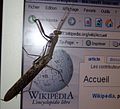Marbled Madagascar mantis
| Marbled Madagascar mantis | ||||||||||||
|---|---|---|---|---|---|---|---|---|---|---|---|---|

Marbled Madagascar mantis ( Polyspilota aeruginosa ), female |
||||||||||||
| Systematics | ||||||||||||
|
||||||||||||
| Scientific name | ||||||||||||
| Polyspilota aeruginosa | ||||||||||||
| ( Goeze , 1778) |
The Marbled Madagascar Mantis ( Polyspilota aeruginosa ) is a Mantis from the family of Mantidae . The species owes its trivial name to its appearance and range, which, however, extends beyond Madagascar .
features
The female of the marbled Madagascar mantis reaches a body length of up to around 90 millimeters, the male is around 80 millimeters tall, making the species one of the larger fishing horrors. The basic color of the marbled Madagascar mantis varies depending on the individual and is composed of green and brown tones. However, specimens can also appear in which one of the two colors is little or no present. The males often have a green color on the flanks of the first pair of wings. The striding legs also have a pink color from the tibia , while the catch legs also show yellow parts. The inside of the muzzle has a bright blue color. This shows a black spot that is directed against the attacker when threatening. The undersides of the second pair of wings are also provided with black eye spots and on the upper edge with alternating white and purple stripes. The lower wings and tentacles are stretched out in the event of a possible predator, so that these colors come into their own and signal the attacker to defend themselves. What is striking is the gray-brown marbling of the species which, in addition to its distribution area, has earned it the German trivial name. The eyes of the species shimmer violet if they are illuminated by a strong light source. The body structure of the fishing insect resembles that of other representatives of the subfamily Mantinae , although this appears comparatively narrow, as with relatives from the Polyspilotini tribe . In this species, too, the dimorphism that is familiar to terrors is present. The comparatively stronger female of the marbled Madagascar mantis has six abdominal segments, as in other species of mantis, while the number of the smaller male is eight. Only the males are able to fly well in this fishing insect.
Similar species

Species similar to the marbled Madagascar mantis are also other members of the genus Polyspilota , including Polyspilota griffini . Other similar terrors can also be found in the family Mantidae and especially in the tribe Polyspilotini . A prominent example is the great Chinese mantis ( Tenodera sinensis ) native to East Asia , which, however, is significantly larger than the marbled Madadagskar mantis after its development is complete.
Occurrence
The marbled Madagascar mantis is common in East Africa including Madagascar . There it prefers bushes and trees in areas with little vegetation.
Way of life
The marbled Madagascar mantis, like many terrors, is a stalker who remains largely motionless. This also serves as camouflage, so that the fishing insect remains largely unseen by both predators and prey. Other arthropods of suitable size are predominantly suitable as prey . The quite aggressive species defends itself against predators if necessary with a threatening gesture or with their hunting weapons.
Reproduction
The female of the marbled Madagascar mantis is in the adult stage after the tenth, the male already after the ninth molt . However, sexual maturity only occurs after four weeks in the female and after two weeks in the male. As is usual with fishing horrors, the flightless female attracts males with the help of their own pheromones . A male can perceive these from a great distance. Pairing can take nine to 15 hours. Even with the marbled Madagascar mantis, cannibalistic behavior on the part of the female can occur during mating. Some time after mating, the female lays up to five ooths at an interval of 10 to 14 days. These are semicircular and egg-shaped, from light to dark brown basic color and up to three centimeters in size. Thicker branches or bark are usually chosen as the storage location. After four to six weeks, up to 100 larvae, each around five millimeters in size, hatch from a discarded ootheca and then grow up. Males of the Madagascar mantis can reach a lifespan of one year, females one of 1.5 years.
Terrariums
The marbled Madagascar mantid is a relatively easy to keep mantid due to its robustness and its low demands. In contrast to other catching horrors suitable for beginners, such as the Ghana praying mantis ( Sphodromantis lineola ) or the Indian giant mantis ( Hierodula membranacea ), it is kept comparatively rarely.
Systematics
The first descriptor Johann August Ephraim Goeze gave the marbled Madagascar mantis the name Mantis aeruginosa in 1778 . Under Hermann Burmeister , however, the species was classified in the genus Polyspilota, which he first described at the same time . The marbled Madagascar mantis has four subspecies with the names. P. a. aeruginosa , P. a. fuscoirrorata , P. a. variegata and P. a. viridis .
gallery
Individual evidence
- ↑ a b c d e Description and husbandry report of the marbled Madagascar mantis from on M&M Wüst ( Link ).
- ↑ a b c d e f Description and husbandry report of the marbled Madagascar mantis on Exotic-Pets.co.uk ( Link ).
- ↑ a b c d e Description and husbandry report of the Marbled Madagascar Mantis on ESRAS ( Link ).
- ↑ a b c d Description and husbandry report of the marbled Madagascar mantis on MantisOnline.de ( [1] ).
- ↑ Systematics of the Marbled Madagascar Mantis on Mantodea Species File ( Link )





